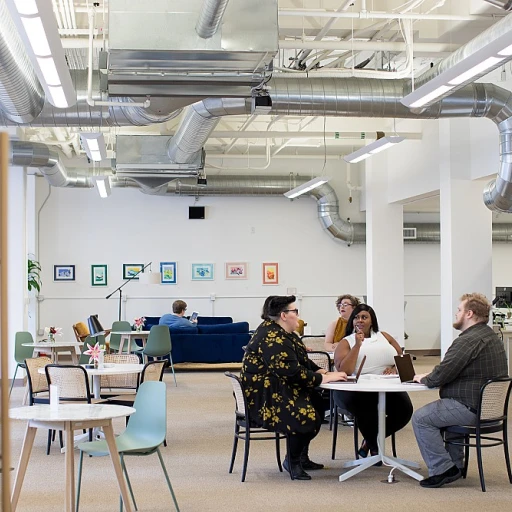
Revolutionizing Remote Collaboration
Reimagining Teamwork with Immersive Technology
The advent of immersive virtual reality is revolutionizing the landscape of remote collaboration, offering a transformative experience for users that traditional video conferencing and collaborative tools often lack. As more organizations transition to a digital-first mindset, incorporating virtual reality environments has become increasingly prevalent. Virtual reality enables users to engage in a computer generated environment where they can interact in real time, enhancing the sense of presence and engagement that remote communication otherwise lacks. This is particularly evident in settings where teams must collaborate across different geographic locations, leveraging augmented reality and mixed reality to merge the virtual with the real. A key component of this transformation is the use of reality headsets and head mounted displays such as the Oculus Rift. These devices provide a wide range field view, creating a seamless immersive experience that mimics in-person interactions. Users can navigate virtual worlds, communicate through avatars, and engage with digital objects as if they were part of a real system. This level of immersion facilitates greater collaboration and decision-making efficiency. Moreover, the integration of haptic feedback in reality technologies is instrumental in making the virtual environment feel tangible. By simulating touch and movement, these systems offer an enriched user experience, crucial for fields such as spinal cord rehabilitation, where virtual reality can aid in patient treatment and recovery. For companies seeking to harness the potential of virtual collaboration, resources are available to learn more about how interactive technologies are shaping the future of work. These insights can guide businesses in adopting VR to enhance both productivity and teamwork. As the adoption of virtual reality continues to grow, overcoming challenges associated with this technology remains pivotal. Addressing the initial costs, technical barriers, and ensuring user training are essential for seamless integration into daily work routines. With the ongoing development in this field, it's evident that virtual reality has the potential to redefine remote collaboration and drive the future of work forward.Transforming Employee Training
Enhancing Learning Through a New Dimension
In the realm of employee training, immersive virtual reality technology is transforming how organizations equip their workforce with the necessary skills and knowledge. Traditional methods often rely on theoretical instruction, but virtual reality offers a more interactive and engaging approach, providing a hands-on, experiential learning environment.
One significant advantage of virtual reality in training is its ability to simulate real-world scenarios safely and cost-effectively. Through computer-generated environments, users can practice complex tasks or navigate high-risk situations without the associated dangers. For instance, in healthcare, trainees can perform virtual procedures, thereby honing their expertise without risking patient safety.
The use of head mounted displays, such as the Oculus Rift, enables a wide range of immersive experiences, granting users a comprehensive field view and the possibility of integrating haptic feedback. This allows for a deeper understanding of the body mechanics involved in tasks, making training more effective.
Additionally, virtual environments offer the flexibility to tailor training programs to individual needs. Whether it's a simulation for managing spinal cord injury cases in rehabilitation or training routine tasks, the customization possibilities are vast. As these programs evolve, a growing number of systems support augmented reality and mixed reality applications, further enhancing the learning experience.
As technology continues to advance, the potential for virtual environments to revolutionize employee training is enormous. With real-time feedback, learners can adjust and correct their actions on the spot, fostering faster learning curves and cultivating a better-prepared workforce.
Boosting Productivity with Virtual Workspaces
Maximizing Efficiency Through Interactive Virtual Environments
In the ever-evolving future of work, the integration of immersive virtual environments is poised to redefine productivity standards. Virtual workspaces, enhanced with advanced virtual reality (VR) technology, offer a plethora of opportunities to elevate efficiency. Unlike traditional setups, these digital domains provide users with an interactive experience where they can collaborate and perform tasks within a three-dimensional space. With the help of technologies like Oculus Rift and mixed reality, employees can enter a virtual environment that replicates real-world offices, factories, or labs. This virtual experience allows teams to come together regardless of geographical disparities. The real-time interaction facilitated by VR headsets and head-mounted displays ensures seamless communication and collaboration, akin to being present in the same room. Such innovative capabilities make VR an indispensable tool for transforming remote collaborations into engaging and productive meetings. Incorporating VR into everyday workflows also has the potential to boost creativity and problem-solving. Immersive environments can emulate complex systems, enabling users to visualize and manipulate data or processes effortlessly. Users can enjoy a wide field view, providing an expansive perspective that helps in tackling challenges more effectively. Moreover, augmented reality and VR systems equipped with haptic feedback can enhance manual tasks where tangible interaction is required. This is particularly beneficial for industries focusing on design, engineering, and even healthcare, where training professionals can simulate real scenarios to refine their skills. Platforms offering computer-generated environments allow users to engage in role-specific drills, improving their operational readiness without physical limitations. When harnessed correctly, these virtual environments can also facilitate a more balanced workflow. Organizations can adopt modern solutions to enhance productivity. For instance, integrating efficient workflow solutions within virtual workspaces can streamline operations and reduce time spent on routine tasks. Embracing these digital advances ensures that businesses remain adaptable, paving the way for a robust and sustainable work culture in the face of future challenges.Overcoming Challenges in Virtual Reality Adoption
Addressing Hurdles in Embracing Reality Technology
The adoption of immersive virtual reality in the workplace, while promising, comes with its set of challenges that need careful consideration. One of the main obstacles is the cost associated with acquiring advanced virtual reality systems such as reality headsets, head-mounted displays, and other computer-generated environments. These expenses can be a significant barrier for small to medium-sized businesses seeking to integrate this technology into their operations.
Furthermore, technical limitations related to virtual reality headsets, like field view constraints and the potential for haptic feedback limitations, can hinder the seamless integration of mixed reality into work environments. Despite the advanced technology, these devices may not always deliver a completely real-world experience, affecting the quality of virtual interactions among users.
Another important aspect that businesses must tackle is the learning curve associated with new virtual technologies. Training employees to effectively use these systems can be time-consuming and resource-intensive. Implementing an immersive experience requires a well-rounded understanding of virtual environments, which can be daunting for many companies.
On a more practical level, ensuring a safe and comfortable physical space for using augmented and mixed reality systems is crucial. Employers need to consider the physical environment to ensure that users have enough room to move freely and safely interact with virtual realities, without encountering real-world hazards.
Despite these challenges, the benefits of implementing virtual reality for remote collaboration, employee training, and boosting productivity make it a worthwhile pursuit for forward-thinking companies. By addressing the initial hurdles with strategic planning and investment, businesses can build a robust framework that supports the use of reality technology, enhancing user experiences and ultimately leading to improved employee well-being and efficiency.
The Role of Virtual Reality in Employee Well-being
Elevating Employee Well-being through Virtual Reality
In the realm of virtual reality, there exists an incredible opportunity to enhance employee well-being in ways previously unimaginable. Immersive experiences created through a virtual environment can offer employees a means of escaping the usual monotony and stress of traditional work settings, which can positively impact their mental health and job satisfaction. Virtual technology allows for the simulation of rehabilitative experiences for employees facing physical challenges or recovery from spinal cord injuries. Using virtual systems, users can engage in rehabilitation exercises that promote body movement and coordination without the risk of injury, all within a safe, controlled environment. Moreover, the integration of VR into wellness programs can promote mental relaxation and encouragement through high-quality immersive experiences. Cognitive relaxation practices, supported by mixed reality and augmented reality environments, can facilitate real-time stress relief by providing a calming escape from the demands of the real system of work. Ensuring user compliance and engagement involves the thoughtful integration of reality technology, such as head-mounted displays and augmented features. The wide range of headsets like the Oculus Rift, combined with a large field view and haptic feedback, make VR experiences more engaging and beneficial to the employee's holistic well-being. These advantages underscore the importance of virtual reality not just as a tool for productivity or training, but as a means to enrich and care for an organization's primary asset – its people. As virtual worlds become more sophisticated and accessible, businesses have a responsibility to explore and implement VR solutions as part of their commitment to employee welfare.Future Trends in Virtual Reality and Work
Evolution of Virtual and Mixed Reality in the Workplace
The future trends in virtual reality (VR) and its integration into the work environment are poised to redefine how employees engage with their tasks and each other. As VR technology evolves, we will witness significant advances in both the applications and user experiences.
One of the key developments lies in the enhancement of current VR systems, such as the Oculus Rift, known for its wide field of view and haptic feedback capabilities. This head-mounted display represents a new era of immersive workspaces, where the virtual environment responds in real time to user interactions. The inclusion of haptic feedback allows users to feel the impact of their virtual actions, which can be particularly beneficial in training and rehabilitation scenarios, including for spinal cord injury patients.
Moreover, the integration of augmented, mixed, and computer-generated reality technologies is likely to expand. This amalgamation will offer a seamless blend of real and virtual worlds, creating more dynamic workspaces where people can operate within a mixed reality environment. These environments could provide real-time data overlays, allowing users to interact with their real surroundings while accessing critical virtual insights.
Future trends also indicate a shift towards incorporating VR training solutions that cater to a wide range of industries, from healthcare to manufacturing. Enhanced by immersive technology, such training can provide tailored, interactive experiences that mimic real-world scenarios with precision.
Finally, the development of lighter, more user-friendly reality headsets will make immersive experiences more accessible to a broader audience. This accessibility can ultimately improve employee well-being by promoting virtual environments that are both engaging and comfortable to navigate.












